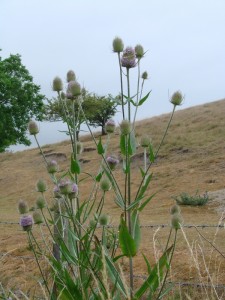Sixteen members met at Blewbury and walked through the village, out to and up Blewburton Hill and back. The expectation was that many butterflies would be seen but the weather ruled this out, only the most hardy species, gatekeepers, meadow browns and ringlets being noted. The walk, though, was most enjoyable. The streams through the village flowed surprisingly vigorously, indicating just how full the chalk aquifers must be after the recent wet summers. Sticklebacks were observed in the streams. In the area of Blewburton Hill the striking blue flowers of chicory made a fine display, as did bedstraws, knapweeds, poppies and many other species of chalk grassland. Sheep had grazed the turf on the hill itself very comprehensively. Some debate developed over the identification of a wild leek on the path below Blewburton Hill: some were sure that it was the common Crow Garlic, others were sure that it was not. The latter plumped for Allium sphaerocephalon, round-headed leek. This, however, is an extreme rarity as a wild species in the UK. It is found as a garden escape and other species of garden origin were noted during the walk.
Most members followed the walk with a very satisfactory lunch in the Red Lion and many bought excellent local cherries in the farm shop nearby. There will be more expeditions from Blewbury!
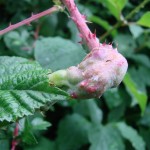
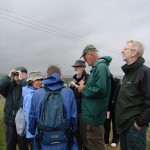
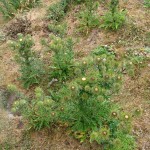
Plants
Crown vetch Securigera varia
Chicory Cichorium intybus
Pendulous sedge Carex pendula
Pellitory-of-the-wall Parietaria officinalis
White Bryony Bryonia alba
Vervain Verbena officinalis
Scentless Mayweed Tripleurospermum inodorum
Dewberry Rubus sect. Eubatus
Corn Sow Thistle Sonchus arvensis
Greater Knapweed Centaurea scabiosa
Hemlock Conium maculatum
Goatsbeard Tragopogon porrifolius
Wild Parsnip Pastinaca sativa
Burnet Saxifrage Pimpinella saxifraga
Hedge Parsley Torilus arvensis
Restharrow Ononsis arvensis
Hoary Ragwort Senecio erucifolius
Teasel Dipsacis fullonium
Nodding (Musk) Thistle Carduus nutans
Meadow Clary Salvia pratensis
Hedge Bedstraw Gallium mollugo
White Campion Silene latifolia
Crow Garlic (?) Allium vineale (?)
Creeping Cinquefoil Potentilla reptans
Burdock Arctium lappa
Wild (Prickly) Lettuce Lactuca virosa
Shrubby Hawkweed Hieracium vagum
Yarrow Achillea millefolium
Stemless Thistle Cirsium acaule
Yellowwort Blackstonia perfoliata
Wild Mignonette Reseda lutea
Carline Thistle Carlina vulgaris
Thyme Thymus sp.
Harebell Campanula rotundifolia
Bristly Ox-tongue Picris echioides
Pineapple Weed Matricaria discoidea
Birds
Corn Bunting
Kestrel
Buzzard
Raven?
Butterflies/Moths
Large White
Gatekeeper
Meadow Brown
Ringlet
Yellow Shell
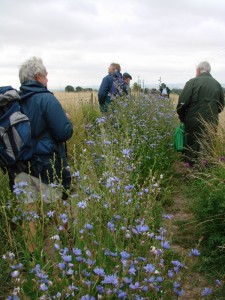
Text by Chris Bucke
Photos by Ricki Bull

